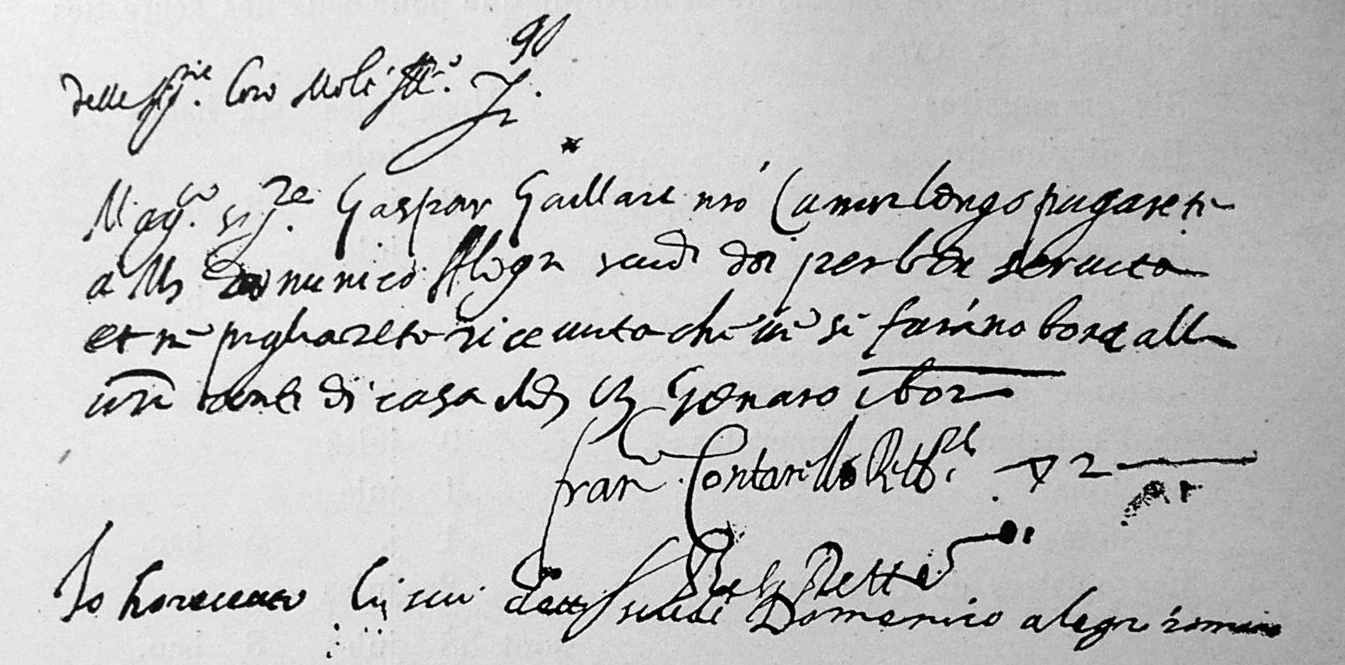Domenico Allegri on:
[Wikipedia]
[Google]
[Amazon]
Domenico Allegri (c. 1585 – 5 September 1629) was an Italian composer and singer of the early  In 1606, Allegri was ''maestro di cappella'' of the church of Santa Maria at
In 1606, Allegri was ''maestro di cappella'' of the church of Santa Maria at
Baroque
The Baroque (, ; ) is a style of architecture, music, dance, painting, sculpture, poetry, and other arts that flourished in Europe from the early 17th century until the 1750s. In the territories of the Spanish and Portuguese empires including t ...
Roman School
In music history, the Roman School was a group of composers of predominantly church music, in Rome, during the 16th and 17th centuries, therefore spanning the late Renaissance and early Baroque eras. The term also refers to the music they produ ...
. He was the second son of the Milanese coachman Costantino Allegri, who lived in Rome with his family, and was a younger brother of the more famous Gregorio Allegri
Gregorio Allegri (17 February 1652) was a Roman Catholic Church, Roman Catholic priest and Italy, Italian composer of the Roman School and brother of Domenico Allegri; he was also a singer. He was born"Allegri, Gregorio" in ''Chambers's Encyclop ...
. Costantino sent three sons, Gregorio, Domenico and Bartolomeo, to study music at San Luigi dei Francesi
The Church of St. Louis of the French ( it, San Luigi dei Francesi, french: Saint Louis des Français, la, S. Ludovici Francorum de Urbe) is a Roman Catholic church in Rome, not far from Piazza Navona. The church is dedicated to the Virgin Mary, ...
, under the ''maestro di capella'' Giovanni Bernardino Nanino
Giovanni Bernardino Nanino (ca. 1560 – 1623) was an Italian composer, teacher and singing master of the late Renaissance and early Baroque eras, and a leading member of the Roman School of composers. He was the younger brother of the some ...
, brother of Giovanni Maria Nanino
Giovanni Maria Nanino (also Nanini; 1543 or 1544 – 11 March 1607) was an Italian composer and teacher of the late Renaissance. He was a member of the Roman School of composers, and was the most influential music teacher in Rome in the late 16t ...
. The little boy had as schoolmate his elder brother Gregorio and then Antonio Cifra, Domenico MassenzioTo distinguish Domenico Allegri from Domenico Massenzio, the young pupils were mentioned as 'big Domenico' («Domenico grande» or «Domenico maggiore») and 'little Domenico' («Domenico piccolo», «Domenicucio» or «Domenico minore»). See also: Antonella Nigro, ''Domenico Massenzio. A new biography with unpublished documents'', in ''Domenico Massenzio Opera omnia'', Critical Edition by Claudio Dall'Albero and Mauro Bacherini, Vol. 1, Milano, Rugginenti, 2008, p. xxxvi. and Paolo Agostini
Paolo Agostino (or Agostini; Augustinus in Latin; c. 1583 – 1629) was an Italian composer and organist of the early Baroque era. He was born perhaps at Vallerano, near Viterbo. He studied under Giovanni Bernardino Nanino, according to the de ...
.
 In 1606, Allegri was ''maestro di cappella'' of the church of Santa Maria at
In 1606, Allegri was ''maestro di cappella'' of the church of Santa Maria at Spello
Spello (in Antiquity: Hispellum) is an ancient town and ''comune'' (township) of Italy, in the province of Perugia in eastern-central Umbria, on the lower southern flank of Mt. Subasio. It is 6 km (4 mi) NNW of Foligno and 10 km (6 ...
, and from September 1609 until April 1610 served in the same role at the church of Santa Maria in Trastevere
The Basilica of Santa Maria in Trastevere ( it, Basilica di Santa Maria in Trastevere); en, Our Lady in Trastevere) is a titular minor basilica in the Trastevere district of Rome, and one of the oldest churches of Rome. The basic floor plan and ...
in Rome. From 3 April 1610 until his death, he held the same position at the Basilica di Santa Maria Maggiore
The Basilica of Saint Mary Major ( it, Basilica di Santa Maria Maggiore, ; la, Basilica Sanctae Mariae Maioris), or church of Santa Maria Maggiore, is a Major papal basilica as well as one of the Seven Pilgrim Churches of Rome and the larges ...
, where he was buried.
Allegri is mainly famous as being one of the first to include specific instrumental accompaniments to sacred vocal music on a small scale. While much of his music is lost, one piece which has survived is the ''Modi quos expositis in choris'' of 1617 which has accompaniments to the voices by two violin
The violin, sometimes known as a ''fiddle'', is a wooden chordophone (string instrument) in the violin family. Most violins have a hollow wooden body. It is the smallest and thus highest-pitched instrument (soprano) in the family in regular ...
s.
References
Bibliography
*Alberto Cametti, ''La scuola dei «pueri cantus» di S. Luigi dei francesi in Roma e i suoi principali allievi (1591-1623): Gregorio, Domenico e Bartolomeo Allegri, Antonio Cifra, Orazio Benevoli'', Torino, Fratelli Bocca, 1915. *Sergio Durante, 'Domenico Allegri', in ''Dizionario enciclopedico universale della musica e dei musicisti'', Torino, UTET, 1983–1999, . *Saverio Franchi, ''Annali della stampa musicale romana dei secoli XVI-XVIII'', Vol. 1/I, IBIMUS, Roma, 2006, . *Antonella Nigro, ''Domenico Massenzio. A new biography with unpublished documents'', in ''Domenico Massenzio Opera omnia'', Critical Edition by Claudio Dall'Albero e Mauro Bacherini, Vol. 1, Milano, Rugginenti, 2008, ISMN M-52013-013-4. *Alberto Pironti, 'Domenico Allegri', in ''Dizionario Biografico degli Italiani'', Roma,Treccani
The ''Enciclopedia Italiana di Scienze, Lettere e Arti'' (Italian for "Italian Encyclopedia of Science, Letters, and Arts"), best known as ''Treccani'' for its developer Giovanni Treccani or ''Enciclopedia Italiana'', is an Italian-language en ...
.
*Colin Timms, 'Domenico Allegri', in '' New Grove Dictionary'', .
{{DEFAULTSORT:Allegri, Domenico
Italian Baroque composers
Italian male classical composers
Italian male singers
Singers from Rome
1580s births
1629 deaths
Roman school composers
17th-century Italian composers
17th-century male musicians